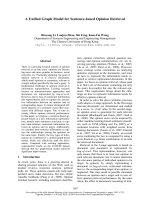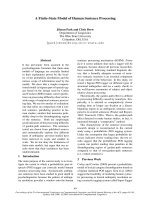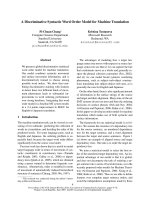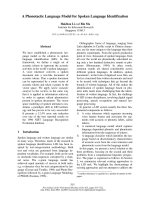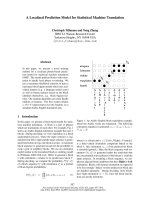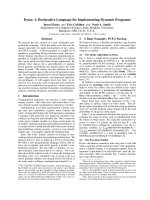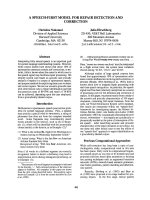Báo cáo khoa học: "A Discriminative Language Model with Pseudo-Negative Samples" pptx
Bạn đang xem bản rút gọn của tài liệu. Xem và tải ngay bản đầy đủ của tài liệu tại đây (159.17 KB, 8 trang )
Proceedings of the 45th Annual Meeting of the Association of Computational Linguistics, pages 73–80,
Prague, Czech Republic, June 2007.
c
2007 Association for Computational Linguistics
A Discriminative Language Model with Pseudo-Negative Samples
Daisuke Okanohara Jun’ichi Tsujii
Department of Computer Science, University of Tokyo
Hongo 7-3-1, Bunkyo-ku, Tokyo, Japan
School of Informatics, University of Manchester
NaCTeM (National Center for Text Mining)
hillbig,tsujii @is.s.u-tokyo.ac.jp
Abstract
In this paper, we propose a novel discrim-
inative language model, which can be ap-
plied quite generally. Compared to the
well known N-gram language models, dis-
criminative language models can achieve
more accurate discrimination because they
can employ overlapping features and non-
local information. However, discriminative
language models have been used only for
re-ranking in specific applications because
negative examples are not available. We
propose sampling pseudo-negative examples
taken from probabilistic language models.
However, this approach requires prohibitive
computational cost if we are dealing with
quite a few features and training samples.
We tackle the problem by estimating the la-
tent information in sentences using a semi-
Markov class model, and then extracting
features from them. We also use an on-
line margin-based algorithm with efficient
kernel computation. Experimental results
show that pseudo-negative examples can be
treated as real negative examples and our
model can classify these sentences correctly.
1 Introduction
Language models (LMs) are fundamental tools for
many applications, such as speech recognition, ma-
chine translation and spelling correction. The goal
of LMs is to determine whether a sentence is correct
or incorrect in terms of grammars and pragmatics.
The most widely used LM is a probabilistic lan-
guage model (PLM), which assigns a probability to
a sentence or a word sequence. In particular, N-
grams with maximum likelihood estimation (NLMs)
are often used. Although NLMs are simple, they are
effective for many applications.
However, NLMs cannot determine correctness
of a sentence independently because the probabil-
ity depends on the length of the sentence and the
global frequencies of each word in it. For exam-
ple,
, where is the probability
of a sentence
given by an NLM, does not always
mean that
is more correct, but instead could occur
when
is shorter than ,orif has more com-
mon words than
. Another problem is that NLMs
cannot handle overlapping information or non-local
information easily, which is important for more ac-
curate sentence classification. For example, a NLM
could assign a high probability to a sentence even if
it does not have a verb.
Discriminative language models (DLMs) have
been proposed to classify sentences directly as cor-
rect or incorrect (Gao et al., 2005; Roark et al.,
2007), and these models can handle both non-local
and overlapping information. However DLMs in
previous studies have been restricted to specific ap-
plications. Therefore the model cannot be used for
other applications. If we had negative examples
available, the models could be trained directly by
discriminating between correct and incorrect sen-
tences.
In this paper, we propose a generic DLM, which
can be used not only for specific applications, but
also more generally, similar to PLMs. To achieve
73
this goal, we need to solve two problems. The first
is that since we cannot obtain negative examples (in-
correct sentences), we need to generate them. The
second is the prohibitive computational cost because
the number of features and examples is very large. In
previous studies this problem did not arise because
the amount of training data was limited and they did
not use a combination of features, and thus the com-
putational cost was negligible.
To solve the first problem, we propose sampling
incorrect sentences taken from a PLM and then
training a model to discriminate between correct and
incorrect sentences. We call these examples Pseudo-
Negative because they are not actually negative sen-
tences. We call this method DLM-PN (DLM with
Pseudo-Negative samples).
To deal with the second problem, we employ an
online margin-based learning algorithm with fast
kernel computation. This enables us to employ com-
binations of features, which are important for dis-
crimination between correct and incorrect sentences.
We also estimate the latent information in sentences
by using a semi-Markov class model to extract fea-
tures. Although there are substantially fewer la-
tent features than explicit features such as words or
phrases, latent features contain essential information
for sentence classification.
Experimental results show that these pseudo-
negative samples can be treated as incorrect exam-
ples, and that DLM-PN can learn to correctly dis-
criminate between correct and incorrect sentences
and can therefore classify these sentences correctly.
2 Previous work
Probabilistic language models (PLMs) estimate the
probability of word strings or sentences. Among
these models, N-gram language models (NLMs) are
widely used. NLMs approximate the probability by
conditioning only on the preceding
words.
For example, let
denote a sentence of words,
. Then, by the chain rule of
probability and the approximation, we have
(1)
The parameters can be estimated using the maxi-
mum likelihood method.
Since the number of parameters in NLM is still
large, several smoothing methods are used (Chen
and Goodman, 1998) to produce more accurate
probabilities, and to assign nonzero probabilities to
any word string.
However, since the probabilities in NLMs depend
on the length of the sentence, two sentences of dif-
ferent length cannot be compared directly.
Recently, Whole Sentence Maximum Entropy
Models (Rosenfeld et al., 2001) (WSMEs) have
been introduced. They assign a probability to
each sentence using a maximum entropy model.
Although WSMEs can encode all features of a
sentence including non-local ones, they are only
slightly superior to NLMs, in that they have the dis-
advantage of being computationally expensive, and
not all relevant features can be included.
A discriminative language model (DLM) assigns
a score
to a sentence , measuring the correct-
ness of a sentence in terms of grammar and prag-
matics, so that
implies is correct and
implies is incorrect. A PLM can be
considered as a special case of a DLM by defining
using . For example, we can take
, where is some threshold, and
is the length of .
Given a sentence
, we extract a feature vector
(
) from it using a pre-defined set of feature
functions
. The form of the function we
use is
(2)
where
is a feature weighting vector.
Since there is no restriction in designing
,
DLMs can make use of both over-lapping and non-
local information in
. We estimate using training
samples
for , where if
is correct and if is incorrect.
However, it is hard to obtain incorrect sentences
because only correct sentences are available from
the corpus. This problem was not an issue for previ-
ous studies because they were concerned with spe-
cific applications and therefore were able to obtain
real negative examples easily. For example, Roark
(2007) proposed a discriminative language model, in
which a model is trained so that a correct sentence
should have higher score than others. The differ-
ence between their approach and ours is that we do
not assume just one application. Moreover, they had
74
For i=1,2,
Choose a word
at random
according to the distribution
If "end of a sentence"
Break
End End
Figure 1: Sample procedure for pseudo-negative ex-
amples taken from N-gram language models.
training sets consisting of one correct sentence and
many incorrect sentences, which were very similar
because they were generated by the same input. Our
framework does not assume any such training sets,
and we treat correct or incorrect examples indepen-
dently in training.
3 Discriminative Language Model with
Pseudo-Negative samples
We propose a novel discriminative language model;
a Discriminative Language Model with Pseudo-
Negative samples (DLM-PN). In this model,
pseudo-negative examples, which are all assumed to
be incorrect, are sampled from PLMs.
First a PLM is built using training data and then
examples, which are almost all negative, are sam-
pled independently from PLMs. DLMs are trained
using correct sentences from a corpus and negative
examples from a Pseudo-Negative generator.
An advantage of sampling is that as many nega-
tive examples can be collected as correct ones, and
a distinction can be clearly made between truly cor-
rect sentences and incorrect sentences, even though
the latter might be correct in a local sense.
For sampling, any PLMs can be used as long
as the model supports a sentence sampling proce-
dure. In this research we used NLMs with interpo-
lated smoothing because such models support effi-
cient sentence sampling. Figure 1 describes the sam-
pling procedure and figure 2 shows an example of a
pseudo-negative sentence.
Since the focus is on discriminating between cor-
rect sentences from a corpus and incorrect sentences
sampled from the NLM, DLM-PN may not able to
classify incorrect sentences that are not generated
from the NLM. However, this does not result in a se-
We know of no program, and animated
discussions about prospects for trade
barriers or regulations on the rules
of the game as a whole, and elements
of decoration of this peanut-shaped
to priorities tasks across both target
countries
Figure 2: Example of a sentence sampled by PLMs
(Trigram).
Corpus
Build a probabilistic language model
Sample sentences
Positive
(Pseudo-) Negative
Binary Classifier
test sentences
Return positive/negative label or score (margin)
Input training examples
Probabilistic LM
(e.g. N-gram LM)
Figure 3: Framework of our classification process.
rious problem, because these sentences, if they exist,
can be filtered out by NLMs.
4 Online margin-based learning with fast
kernel computation
The DLM-PN can be trained by using any binary
classification learning methods. However, since the
number of training examples is very large, batch
training has suffered from prohibitively large com-
putational cost in terms of time and memory. There-
fore we make use of an online learning algorithm
proposed by (Crammer et al., 2006), which has a
much smaller computational cost. We follow the
definition in (Crammer et al., 2006).
The initiation vector
is initialized to and for
each round the algorithm observes a training exam-
ple
and predicts its label to be either
or . After the prediction is made, the true la-
bel
is revealed and the algorithm suffers an instan-
taneous hinge-loss
which reflects the degree to which its prediction was
wrong. If the prediction was wrong, the parameter
75
is updated as
(3)
subject to
and (4)
where
is a slack term and is a positive parameter
which controls the influence of the slack term on the
objective function. A large value of
will result in a
more aggressive update step. This has a closed form
solution as
(5)
where
. As in SVMs, a fi-
nal weight vector can be represented as a kernel-
dependent combination of the stored training exam-
ples.
(6)
Using this formulation the inner product can be re-
placed with a general Mercer kernel
such
as a polynomial kernel or a Gaussian kernel.
The combination of features, which can capture
correlation information, is important in DLMs. If
the kernel-trick (Taylor and Cristianini, 2004) is ap-
plied to online margin-based learning, a subset of
the observed examples, called the active set, needs
to be stored. However in contrast to the support set
in SVMs, an example is added to the active set every
time the online algorithm makes a prediction mis-
take or when its confidence in a prediction is inad-
equately low. Therefore the active set can increase
in size significantly and thus the total computational
cost becomes proportional to the square of the num-
ber of training examples. Since the number of train-
ing examples is very large, the computational cost is
prohibitive even if we apply the kernel trick.
The calculation of the inner product between two
examples can be done by intersection of the acti-
vated features in each example. This is similar to
a merge sort and can be executed in
time
where
is the average number of activated fea-
tures in an example. When the number of examples
in the active set is
, the total computational cost is
. For fast kernel computation, the Poly-
nomial Kernel Inverted method (PKI)) is proposed
(Kudo and Matsumoto, 2003), which is an exten-
sion of Inverted Index in Information Retrieval. This
algorithm uses a table
for each feature item,
which stores examples where a feature
is fired.
Let
be the average of over all feature item.
Then the kernel computation can be performed in
time which is much less than the normal
kernel computation time when
. We can eas-
ily extend this algorithm into the online setting by
updating
when an observed example is added
to an active set.
5 Latent features by semi-Markov class
model
Another problem for DLMs is that the number of
features becomes very large, because all possible N-
grams are used as features. In particular, the mem-
ory requirement becomes a serious problem because
quite a few active sets with many features have to be
stored, not only at training time, but also at classi-
fication time. One way to deal with this is to filter
out low-confidence features, but it is difficult to de-
cide which features are important in online learning.
For this reason we cluster similar N-grams using a
semi-Markov class model.
The class model was originally proposed by (Mar-
tin et al., 1998). In the class model, determinis-
tic word-to-class mappings are estimated, keeping
the number of classes much smaller than the num-
ber of distinct words. A semi-Markov class model
(SMCM) is an extended version of the class model,
a part of which was proposed by (Deligne and BIM-
BOT, 1995). In SMCM, a word sequence is par-
titioned into a variable-length sequence of chunks
and then chunks are clustered into classes (Figure 4).
How a chunk is clustered depends on which chunks
are adjacent to it.
The probability of a sentence
,ina
bi-gram class model is calculated by
(7)
On the other hand, the probabilities in a bi-gram
semi-Markov class model are calculated by
(8)
where
varies over all possible partitions of ,
and denote the start and end positions respec-
tively of the
-th chunk in partition , and
76
for all . Note that each word or variable-
length chunk belongs to only one class, in contrast
to a hidden Markov model where each word can be-
long to several classes.
Using a training corpus, the mapping is estimated
by maximum likelihood estimation. The log like-
lihood of the training corpus (
) in a bi-
gram class model can be calculated as
(9)
(10)
(11)
where , and are frequencies of
a word
, a class and a class bi-gram in the
training corpus. In (11) only the first term is used,
since the second term does not depend on the class
allocation. The class allocation problem is solved by
an exchange algorithm as follows. First, all words
are assigned to a randomly determined class. Next,
for each word
, we move it to the class for which
the log-likelihood is maximized. This procedure is
continued until the log-likelihood converges to a lo-
cal maximum. A naive implementation of the clus-
tering algorithm scales quadratically to the number
of classes, since each time a word is moved between
classes, all class bi-gram counts are potentially af-
fected. However, by considering only those counts
that actually change, the algorithm can be made to
scale somewhere between linearly and quadratically
to the number of classes (Martin et al., 1998).
In SMCM, partitions of each sentence are also de-
termined. We used a Viterbi decoding (Deligne and
BIMBOT, 1995) for the partition. We applied the
exchange algorithm and the Viterbi decoding alter-
nately until the log-likelihood converged to the local
maximum.
Since the number of chunks is very large, for ex-
ample, in our experiments we used about
million
chunks, the computational cost is still large. We
therefore employed the following two techniques.
The first was to approximate the computation in the
exchange algorithm; the second was to make use of
w
1
w
2
w
3
w
4
w
5
w
6
w
7
w
8
c
1
c
2
c
3
c
4
Figure 4: Example of assignment in semi-Markov
class model. A sentence is partitioned into variable-
length chunks and each chunk is assigned a unique
class number.
bottom-up clustering to strengthen the convergence.
In each step in the exchange algorithm, the ap-
proximate value of the change of the log-likelihood
was examined, and the exchange algorithm applied
only if the approximate value was larger than a pre-
defined threshold.
The second technique was to reduce memory re-
quirements. Since the matrices used in the exchange
algorithm could become very large, we clustered
chunks into
classes and then again we clustered
these two into
each, thus obtaining classes. This
procedure was applied recursively until the number
of classes reached a pre-defined number.
6 Experiments
6.1 Experimental Setup
We partitioned a BNC-corpus into model-train,
DLM-train-positive, and DLM-test-positive sets.
The numbers of sentences in model-train, DLM-
train-positive and DLM-test-positive were
k,
k, and k respectively. An NLM was built
using model-train and Pseudo-Negative examples
(
k sentences) were sampled from it. We mixed
sentences from DLM-train-positive and the Pseudo-
Negative examples and then shuffled the order of
these sentences to make DLM-train. We also con-
structed DLM-test by mixing DLM-test-positive and
k new (not already used) sentences from the
Pseudo-Negative examples. We call the sentences
from DLM-train-positive “positive” examples and
the sentences from the Pseudo-Negative examples
“negative” examples in the following. From these
sentences the ones with less than
words were ex-
cluded beforehand because it was difficult to decide
whether these sentences were correct or not (e.g.
77
Accuracy (%) Training time (s)
Linear classifier
word tri-gram 51.28 137.1
POS tri-gram 52.64 85.0
SMCM bi-gram ( ) 51.79 304.9
SMCM bi-gram ( ) 54.45 422.1
rd order Polynomial Kernel
word tri-gram 73.65 20143.7
POS tri-gram 66.58 29622.9
SMCM bi-gram ( ) 67.11 37181.6
SMCM bi-gram ( ) 74.11 34474.7
Table 1: Performance on the evaluation data.
compound words).
Let
be the number of classes in SMCMs. Two
SMCMs, one with
and the other with
, were constructed from model-train. Each
SMCM contained
million extracted chunks.
6.2 Experiments on Pseudo-Examples
We examined the property of a sentence being
Pseudo-Negative, in order to justify our framework.
A native English speaker and two non-native En-
glish speaker were asked to assign correct/incorrect
labels to
sentences in DLM-train
1
. The result
for an native English speaker was that all positive
sentences were labeled as correct and all negative
sentences except for one were labeled as incorrect.
On the other hand, the results for non-native English
speakers are 67
and 70 . From this result, we
can say that the sampling method was able to gen-
erate incorrect sentences and if a classifier can dis-
criminate them, the classifier can also discriminate
between correct and incorrect sentences. Note that
it takes an average of 25 seconds for the native En-
glish speaker to assign the label, which suggests that
it is difficult even for a human to determine the cor-
rectness of a sentence.
We then examined whether it was possible to dis-
criminate between correct and incorrect sentences
using parsing methods, since if so, we could have
used parsing as a classification tool. We exam-
ined
sentences using a phrase structure parser
(Charniak and Johnson, 2005) and an HPSG parser
1
Since the PLM also made use of the BNC-corpus for posi-
tive examples, we were not able to classify sentences based on
word occurrences
(Miyao and Tsujii, 2005). All sentences were parsed
correctly except for one positive example. This
result indicates that correct sentences and pseudo-
negative examples cannot be differentiated syntacti-
cally.
6.3 Experiments on DLM-PN
We investigated the performance of classifiers and
the effect of different sets of features.
For N-grams and Part of Speech (POS), we used
tri-gram features. For SMCM, we used bi-gram fea-
tures. We used DLM-train as a training set. In all
experiments, we set
where is a parame-
ter in the classification (Section 4). In all kernel ex-
periments, a
rd order polynomial kernel was used
and values were computed using PKI (the inverted
indexing method). Table 1 shows the accuracy re-
sults with different features, or in the case of the
SMCMs, different numbers of classes. This result
shows that the kernel method is important in achiev-
ing high performance. Note that the classifier with
SMCM features performs as well as the one with
word.
Table 2 shows the number of features in each
method. Note that a new feature is added only if the
classifier needs to update its parameters. These num-
bers are therefore smaller than the possible number
of all candidate features. This result and the previ-
ous result indicate that SMCM achieves high perfor-
mance with very few features.
We then examined the effect of PKI. Table 3
shows the results of the classifier with
rd order
polynomial kernel both with and without PKI. In
this experiment, only
sentences in DLM-train
78
# of distinct features
word tri-gram 15773230
POS tri-gram 35376
SMCM ( ) 9335
SMCM ( ) 199745
Table 2: The number of features.
training time (s) prediction time (ms)
Baseline 37665.5 370.6
+ Index 4664.9 47.8
Table 3: Comparison between classification perfor-
mance with/without index
Figure 5: Margin distribution using SMCM bi-gram
features.
were used for both experiments because training us-
ing all the training data would have required a much
longer time than was possible with our experimental
setup.
Figure 5 shows the margin distribution for pos-
itive and negative examples using SMCM bi-gram
features. Although many examples are close to the
border line (margin
), positive and negative ex-
amples are distributed on either side of
. Therefore
higher recall or precision could be achieved by using
a pre-defined margin threshold other than
.
Finally, we generated learning curves to examine
the effect of the size of training data on performance.
Figure 6 shows the result of the classification task
using SMCM-bi-gram features. The result suggests
that the performance could be further improved by
enlarging the training data set.
Figure 6: A learning curve for SMCM ( ).
The accuracy is the percentage of sentences in the
evaluation set classified correctly.
7 Discussion
Experimental results on pseudo-negative examples
indicate that combination of features is effective in
a sentence discrimination method. This could be
because negative examples include many unsuitable
combinations of words such as a sentence contain-
ing many nouns. Although in previous PLMs, com-
bination of features has not been discussed except
for the topic-based language model (David M. Blei,
2003; Wang et al., 2005), our result may encourage
the study of the combination of features for language
modeling.
A contrastive estimation method (Smith and Eis-
ner, 2005) is similar to ours with regard to construct-
ing pseudo-negative examples. They build a neigh-
borhood of input examples to allow unsupervised es-
timation when, for example, a word is changed or
deleted. A lattice is constructed, and then parame-
ters are estimated efficiently. On the other hand, we
construct independent pseudo-negative examples to
enable training. Although the motivations of these
studies are different, we could combine these two
methods to discriminate sentences finely.
In our experiments, we did not examine the result
of using other sampling methods, For example, it
would be possible to sample sentences from a whole
sentence maximum entropy model (Rosenfeld et al.,
2001) and this is a topic for future research.
79
8 Conclusion
In this paper we have presented a novel discrimi-
native language model using pseudo-negative exam-
ples. We also showed that an online margin-based
learning method enabled us to use half a million sen-
tences as training data and achieve
accuracy in
the task of discrimination between correct and in-
correct sentences. Experimental results indicate that
while pseudo-negative examples can be seen as in-
correct sentences, they are also close to correct sen-
tences in that parsers cannot discriminate between
them.
Our experimental results also showed that com-
bination of features is important for discrimination
between correct and incorrect sentences. This con-
cept has not been discussed in previous probabilistic
language models.
Our next step is to employ our model in machine
translation and speech recognition. One main diffi-
culty concerns how to encode global scores for the
classifier in the local search space, and another is
how to scale up the problem size in terms of the
number of examples and features. We would like to
see more refined online learning methods with ker-
nels (Cheng et al., 2006; Dekel et al., 2005) that we
could apply in these areas.
We are also interested in applications such as con-
structing an extended version of a spelling correc-
tion tool by identifying incorrect sentences.
Another interesting idea is to work with proba-
bilistic language models directly without sampling
and find ways to construct a more accurate discrim-
inative model.
References
Eugene Charniak and Mark Johnson. 2005. Coarse-to-
fine n-best parsing and maxent discriminative rerank-
ing. In Proc. of ACL 05, pages 173–180, June.
Stanley F. Chen and Joshua Goodman. 1998. An empir-
ical study of smoothing techniques for language mod-
eling. Technical report, Harvard Computer Science
Technical report TR-10-98.
Li Cheng, S V N Vishwanathan, Dale Schuurmans, Shao-
jun Wang, and Terry Caelli. 2006. Implicit online
learning with kernels. In NIPS 2006.
Koby Crammer, Ofer Dekel, Joseph Keshet, Shai Shalev-
Shwartz, and Yoram Singer. 2006. Online passive-
aggressive algorithms. Journal of Machine Learning
Research.
Michael I. Jordan David M. Blei, Andrew Y. Ng. 2003.
Latent dirichlet allocation. Journal of Machine Learn-
ing Research., 3:993–1022.
Ofer Dekel, Shai Shalev-Shwartz, and Yoram Singer.
2005. The forgetron: A kernel-based perceptron on
a fixed budget. In Proc. of NIPS.
Sabine Deligne and Fr´ed´eric BIMBOT. 1995. Language
modeling by variable length sequences: Theoretical
formulation and evaluation of multigrams. In Proc.
ICASSP ’95, pages 169–172.
Jianfeng Gao, Hao Yu, Wei Yuan, and Peng Xu. 2005.
Minimum sample risk methods for languagemodeling.
In Proc. of HLT/EMNLP.
Taku Kudo and Yuji Matsumoto. 2003. Fast methods for
kernel-based text analysis. In ACL.
Sven Martin, J¨org Liermann, and Hermann Ney. 1998.
Algorithms for bigram and trigram word clustering.
Speech Communicatoin, 24(1):19–37.
Yusuke Miyao and Jun’ichi Tsujii. 2005. Probabilistic
disambiguation models for wide-coverage hpsg pars-
ing. In Proc. of ACL 2005., pages 83–90, Ann Arbor,
Michigan, June.
Brian Roark, Murat Saraclar, and Michael Collins. 2007.
Discriminative n-gram language modeling. computer
speech and language. Computer Speech and Lan-
guage, 21(2):373–392.
Roni Rosenfeld, Stanley F. Chen, and Xiaojin Zhu. 2001.
Whole-sentence exponential language models: a ve-
hicle for linguistic-statistical integration. Computers
Speech and Language, 15(1).
Noah A. Smith and Jason Eisner. 2005. Contrastive esti-
mation: Training log-linear models on unlabeled data.
In Proc. of ACL.
John S. Taylor and Nello. Cristianini. 2004. Kernel
Methods for Pattern Analysis. Cambiridge Univsity
Press.
Shaojun Wang, Shaomin Wang, Russell Greiner, Dale
Schuurmans, and Li Cheng. 2005. Exploiting syntac-
tic, semantic and lexical regularities in language mod-
eling via directed markov random fields. In Proc. of
ICML.
80

